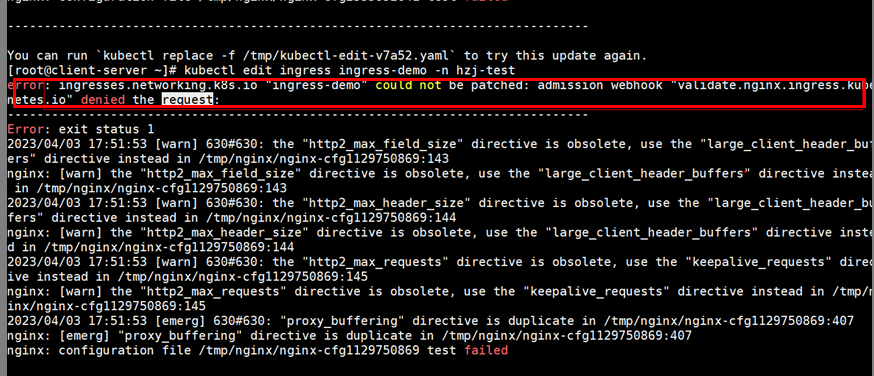Advanced Configuration of Nginx Ingress Controller
Parameter Optimization in High-Concurrency Scenarios
In high-concurrency scenarios, you can configure parameters for optimization in either of the following ways:
- Use ConfigMap to optimize the overall parameters of Nginx Ingress Controller.
- Use InitContainers to optimize the kernel parameters of Nginx Ingress Controller.
The optimized value.yaml configuration file is as follows:
controller:
image:
repository: registry.k8s.io/ingress-nginx/controller
registry: ""
image: ""
tag: "v1.5.1" # Controller version
digest: ""
ingressClassResource:
name: ccedemo # The name of each Ingress Controller in the same cluster must be unique and cannot be nginx or cce.
controllerValue: "k8s.io/ingress-nginx-demo" # The listening identifier of each Ingress Controller in the same cluster must be unique and cannot be set to k8s.io/ingress-nginx.
ingressClass: ccedemo # The name of each Ingress Controller in the same cluster must be unique and cannot be nginx or cce.
service:
annotations:
kubernetes.io/elb.id: 5083f225-9bf8-48fa-9c8b-67bd9693c4c0 #ELB ID
kubernetes.io/elb.class: performance # This annotation is required only for dedicated load balancers.
# Nginx parameter optimization
config:
keep-alive-requests: 10000
upstream-keepalive-connections: 200
max-worker-connections: 65536
# Kernel parameter optimization
extraInitContainers:
- name: init-myservice
image: busybox
securityContext:
privileged: true
command: ['sh', '-c', 'sysctl -w net.core.somaxconn=65535;sysctl -w net.ipv4.ip_local_port_range="1024 65535"']
extraVolumeMounts: # Mount the /etc/localtime file on the node to synchronize the time zone.
- name: localtime
mountPath: /etc/localtime
readOnly: true
extraVolumes:
- name: localtime
type: Hostpath
hostPath:
path: /etc/localtime
admissionWebhooks: # Disable webhook authentication.
enabled: false
patch:
enabled: false
resources: # Set the controller's resource limit, which can be customized.
requests:
cpu: 200m
memory: 200Mi
defaultBackend: # Set defaultBackend.
enabled: true
image:
repository: registry.k8s.io/defaultbackend-amd64
registry: ""
image: ""
tag: "1.5"
digest: ""
admissionWebhook Configuration
Nginx Ingress Controller supports admissionWebhook configuration. You can configure the controller.admissionWebhook parameter to verify the validity of ingress objects. This prevents ingress-controller from continuously reloading resources due to incorrect configuration, which may cause service interruption.

- When the admissionWebhook feature is used, webhook-related configurations must be enabled on the API server, including MutatingAdmissionWebhook and ValidatingAdmissionWebhook.
The feature switch is --admission-control=MutatingAdmissionWebhook,ValidatingAdmissionWebhook.
If it is not enabled, submit a service ticket to enable it.
- After admissionWebhook is enabled, if you need to uninstall and reinstall Nginx Ingress Controller, residual secrets exist and need to be manually cleared.
The value.yaml configuration file for enabling admissionWebhook is as follows:
controller:
image:
repository: registry.k8s.io/ingress-nginx/controller
registry: ""
image: ""
tag: "v1.5.1" # Controller version
digest: ""
ingressClassResource:
name: ccedemo # The name of each Ingress Controller in the same cluster must be unique and cannot be nginx or cce.
controllerValue: "k8s.io/ingress-nginx-demo" # The listening identifier of each Ingress Controller in the same cluster must be unique and cannot be set to k8s.io/ingress-nginx.
ingressClass: ccedemo # The name of each Ingress Controller in the same cluster must be unique and cannot be nginx or cce.
service:
annotations:
kubernetes.io/elb.id: 5083f225-9bf8-48fa-9c8b-67bd9693c4c0 #ELB ID
kubernetes.io/elb.class: performance # This annotation is required only for dedicated load balancers.
config:
keep-alive-requests: 100
extraVolumeMounts: # Mount the /etc/localtime file on the node to synchronize the time zone.
- name: localtime
mountPath: /etc/localtime
readOnly: true
extraVolumes:
- name: localtime
type: Hostpath
hostPath:
path: /etc/localtime
admissionWebhooks:
annotations: {}
enabled: true
extraEnvs: []
failurePolicy: Fail
port: 8443
certificate: "/usr/local/certificates/cert"
key: "/usr/local/certificates/key"
namespaceSelector: {}
objectSelector: {}
labels: {}
existingPsp: ""
networkPolicyEnabled: false
service:
annotations: {}
externalIPs: []
loadBalancerSourceRanges: []
servicePort: 443
type: ClusterIP
createSecretJob:
resources: #Annotation{}
limits:
cpu: 20m
memory: 40Mi
requests:
cpu: 10m
memory: 20Mi
patchWebhookJob:
resources: {}
patch:
enabled: true
image:
registry: registry.k8s.io #registry.k8s.io is the image repository of the webhook official website. Replace it with the address of the repository where the image is located.
image: ingress-nginx/kube-webhook-certgen # webhook image
tag: v1.1.1
digest: ""
pullPolicy: IfNotPresent
priorityClassName: ""
podAnnotations: {}
nodeSelector:
kubernetes.io/os: linux
tolerations: []
labels: {}
securityContext:
runAsNonRoot: true
runAsUser: 2000
fsGroup: 2000
resources: # Set the controller's resource limit, which can be customized.
requests:
cpu: 200m
memory: 200Mi
defaultBackend: # Set defaultBackend.
enabled: true
image:
repository: registry.k8s.io/defaultbackend-amd64
registry: ""
image: ""
tag: "1.5"
digest: ""
Check whether admissionWebhook is verified when incorrect annotations are configured for the ingress.
For example, configure the following incorrect annotations for the ingress:
...
annotations:
nginx.ingress.kubernetes.io/auth-tls-pass-certificate-to-upstream: "false"
nginx.ingress.kubernetes.io/auth-tls-verify-client: optional
nginx.ingress.kubernetes.io/auth-tls-verify-depth: "1"
...
When the ingress service is created, the following interception information is displayed:

Feedback
Was this page helpful?
Provide feedbackThank you very much for your feedback. We will continue working to improve the documentation.See the reply and handling status in My Cloud VOC.
For any further questions, feel free to contact us through the chatbot.
Chatbot





